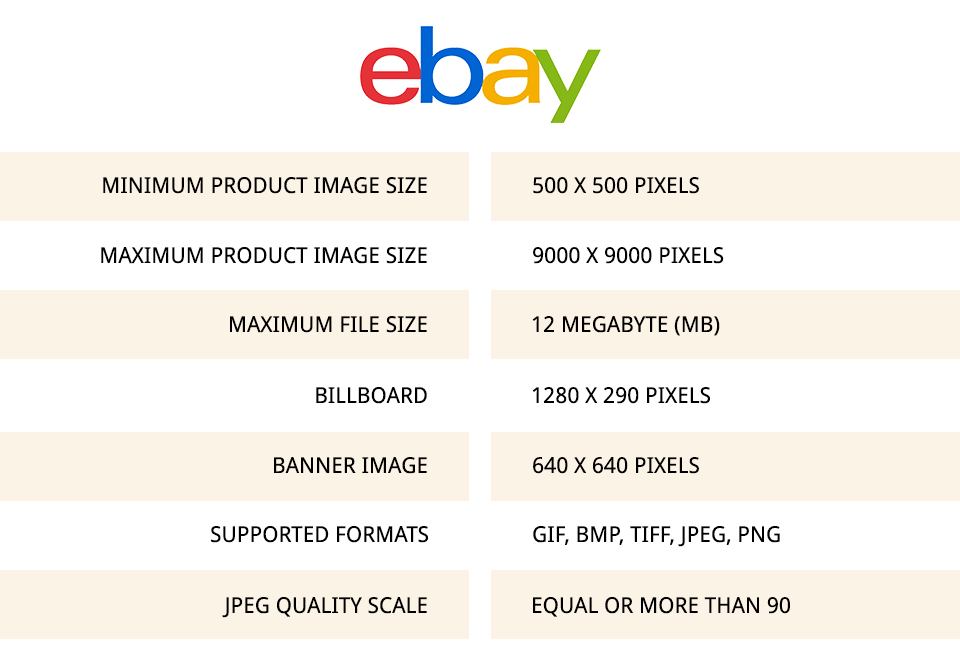
A majority of sellers intend to list their products on the eBay marketplace. However, with ever-growing competition on the platform, it becomes imperative that in-depth competitor research and analysis is done to stay afloat. Sellers must adopt the right approach to engage their potential buying audience and make more sales. As a part of an effective sales strategy, most sellers focus on editing and optimizing their product photos on eBay to bring in more engagement and get more conversions. However, it is not possible to do so without adhering to eBay’s stringent image policies and guidelines. Even a simple size issue in your product image can pose a major problem in the approval of your listings, and stand as a roadblock to your eBay selling game.
We present to you every possible detail pertaining to optimizing and uploading photos to your eBay product listing in order to achieve success strategically. So, without further ado, let’s get started!
Vital Technical Requirements for eBay Product Images
Here are a few important technical requirements that you must take note of before you actually perform eBay image optimization for your product listings:
- The minimum size that has been prescribed for product images on your eBay listings is 500×500 pixels
- The maximum size that has been prescribed for product images on your eBay listings is 9,000 x 9,000 pixels
- The maximum file size limit is 12 Megabyte (MB)
- The various image formats accepted by eBay include GIF, BMP, TIFF, JPEG, and PNG
- If the product image is in the JPEG format, then the quality scale should be either equal to 90 or more than that
- Refrain from scaling up your thumbnail images to achieve the required size limit – you might end up making them distorted or pixelated
- Billboard specifications are 1280 x 290 pixels
- The specifications for the banner image laid down is 640 x 640 pixels.

However, the maximum and minimum file sizes have been clearly laid down for the product images as per eBay’s image size guidelines, but you can still play around with it to make them fit into a particular space on the listing page.
Quality Requirements As Per eBay Image Policy
Before actually heading towards capturing product images for your eBay listings, you must first be well-versed with the various quality requirements laid down as part of their eBay image policy. Here are some key points for your ready reference:
1. White background

The product photos must be captured in preferably white or light grey color background. This is, in fact, one of the most important eBay image optimization rules every seller must follow. Also, it should be clean and clutter-free, and not distracting for the potential audience. Avoid using dark or black color backgrounds for your product photos while adhering to eBay image guidelines.
2. Primary Product Image
A primary product image is the one that depicts the product from the front angle and gives a clear picture to the potential buying audience. While setting a product image as primary, you must ensure that it has been taken from a decent angle giving a brief overview of what the product looks like.
Since it will be the first image that your prospects will see, make sure that you give a frontal view rather than a side angled one. Of course, it is better to give a close-up look showcasing the intricate details clearly.
3. Image cropping
Image cropping also comes under the purview of eBay image optimization. If you intend to crop the product images, you can surely do so but you need to maintain a specific aspect ratio and also ensure that you don’t cut out any part of the product while doing so. Though there’s no harm in cropping, but you need to make sure that the important details aren’t missed out.
4. Dual View
As an eBay seller, you are allowed to upload a dual-view wherein you demonstrate both the front and side of a single product intended to sell. On a particular product listing, two representations of a product can be uploaded with a front and back view. It will be similar to having two mirrored representations of the product in a single frame giving a detailed overview of the product.
5. Multiple angles
As part of the eBay image optimization process, you can also upload several angles and views of a particular product on your listing to render a better understanding to your prospective buying audience. The secondary images you upload on your product pages can include multiple angles of the same product.
The above-mentioned quality requirements will come in handy while you upload eBay images onto your listings. Now, let us head towards knowing the various eBay image optimization tips and tactics that you must adopt to accomplish product photos of exceptional quality.
Let our image editing experts help you accentuate the beauty in your eBay photos with cost-effective, result-oriented solutions.

How to Capture Exceptional eBay Photos – 7 Useful Tips to Follow
Looking for some amazing eBay image optimization tips to make a great first impression in the minds of your target audience? Here are a few handy tips for you to leverage to capture and optimize your images on your eBay listings in a better and more effective way:
1. Make use of high-resolution pictures
You need to make sure that you use high-resolution product images on your listings in order to ensure an impactful first impression on your potential buying audience. What you can do for this is set your camera settings to the highest resolution possible so that the quality of the photos is always up to the mark.
2. Shoot the entire product
One of the key eBay image optimization tips is that you should capture the entire product while shooting. The main product must fill the frame entirely. Remember that the product must be visible clearly and no portion is missed from the frame.
3. Refrain from using the filters
Avoid using too many filters and try to shoot the product photos in natural lighting as much as possible. This not only gives a natural look to the product, but also makes it appear real and genuine. Your potential buyers must be able to get a real picture of what your product looks like rather than deceiving them. Don’t try to mislead them with unrealistic filters and enhancements – it won’t really help and might give a rather bad impression.
4. Maintain stability

Apart from the eBay image optimization tips mentioned above, minimizing camera shake while capturing the product is also crucial to take note of. By doing so, the captured product might look blurry and of low quality. It can hamper the entire look of your product. You can use a tripod in order to avoid shaking your hands while capturing the product. A tripod can come in handy to give you that extra stability you are looking for.
5. Capture multiple shots of the same product
Try to capture different shots of a single product while the shoot is going on. You can, later on, pick the best one from the captured shots. This is just to save you from the hassles of reshooting. If possible, experiment with different shots and try to capture close-ups as well.
6. Experiment with the angles
While planning the shoot, make sure that your checklist includes capturing products from multiple angles and views. This would give a better understanding of your product to your potential audience and render a clearer view of the product intended to be sold on the eBay platform.
7. Be consistent in your approach
Try to be as consistent as possible with your image style while carrying out eBay image optimization. This will help you build your brand better and also generate credibility thereof. You need to make sure that you present your products in a particular way to allow your prospective audience to identify the brand instantly. By doing this, you can actually create a sense of trust for your business.
Now that you know how you can capture outstanding eBay photos with these amazing tips to sell on eBay marketplace, let us now move on to throw some light on the various eBay image mistakes that most sellers make and how you can possibly avoid them by complying with eBay image policy to garner more sales.
5 common eBay image mistakes to avoid in compliance with eBay image guidelines
As an eBay seller, you might commit certain mistakes in your listings that could hamper your sales game to a great extent and also put a couple of workflow roadblocks in front of you. Here are a few common mistakes that sellers can avoid:
1. Uploading a low-quality image

A common mistake that most sellers make is uploading a low-resolution product image. By doing so, you might lose your potential buying audience. So, you need to be very careful while uploading product photos to your product pages.
2. Using only a single image per listing
If you are uploading only one or two product images to your listing, then you are definitely not making the most of the allowed limit of up to 12 images. As per eBay image guidelines, you can upload up to 12 images per listing, and adding only one or two would mean underutilizing the opportunity offered to you by eBay. Go ahead and grab this opportunity by uploading multiple product images with different angles and views to give a better idea of the product you intend to sell. More the images, the better will be the understanding of the product. You can opt for offshore eBay photo editing services to get the most out of your product photos. Infact, with an accurate demonstration of your products, your potential customers will be able to make a well-informed purchase decision without giving much of a thought.
3. Adding incomplete description
Sometimes, to save themselves from the hassle, eBay sellers tend to write brief descriptions not elaborating and highlighting the crucial derails pertaining to their offered products. An insufficient description is another critical mistake that sellers commit to saving time. When you provide incomplete information about your product, chances are that your prospects switch to a similar product offered by your competitor especially when they get detailed descriptions pertaining to the product from them. So, try to incorporate as much well-detailed, relevant information as possible. Don’t shy away from highlighting the product USPs along with the key benefits and features.
4. Drawing the attention away from the product
As an eBay seller, you obviously don’t want to distract your audience by incorporating additional elements or objects, thereby driving the attention away from the product offered. Some elements include promotional text, copyright watermarks, borders, props, logo, barcodes, stickers, to name a few. These extra elements contribute to making the product photo distracting and shift your prospects’ focus to more trivial aspects of the photo. You must try to make the product photo clean and clutter-free as much as possible while carrying out eBay image optimization.
5. Making the background more distracting
Another mistake sellers may commit is using a noisy background for their product images. Even a perfectly captured product photo can look unappealing with a distracting background. Believe it or not, it is quite annoying for the buyers who intend to get a clearer view of the product they wish to purchase. Also, a noisy or cluttered background in a way violates eBay image guidelines and must be avoided at all times.
Final Words
Go through the above-mentioned tips to garner the attention of your potential buying audience and make more sales with effective eBay image optimization processes. By complying with eBay image guidelines including size requirements, technical specifications, and preventing some common mistakes that most sellers commit, you can take your online store to new heights.
Partner with Data4eCom
Data4eCom is a reliable and experienced offshore product listing company offering cost-effective image editing and optimization solutions to sellers spanning across the globe. Get in touch with one of our eCommerce virtual assistants at info@data4ecom.com to take things forward. Ask for a FREE trial now!
More…
1. Can you use stock photos on eBay?
Sure, you can! However, the stock photos must be from your product vendor otherwise you are bound to get flagged due to a violation of eBay’s image policy.
2. What ratio are eBay photos?
As per the eBay image optimization rules, the aspect ratio that will be best for your eBay photos is 1:1.
3. How to use eBay’s Popular ‘Image Search’ Function?
It was earlier introduced in 2017 to search across the marketplace using photos. You can no longer use this function anymore since eBay has temporarily discontinued the ‘image search’ facility for both Android and iOS mobile apps in the latest versions. Click here for details.


